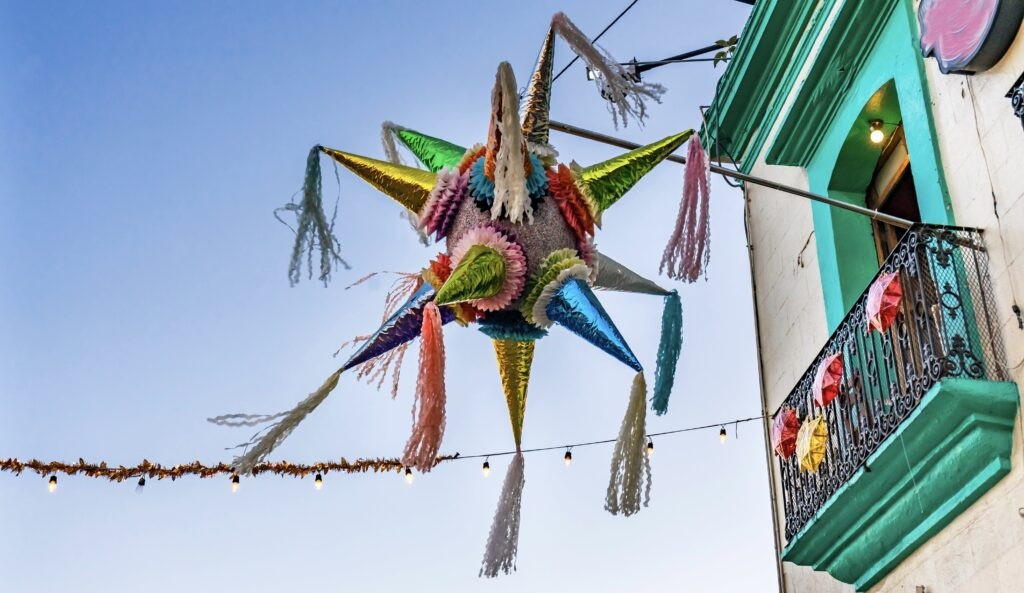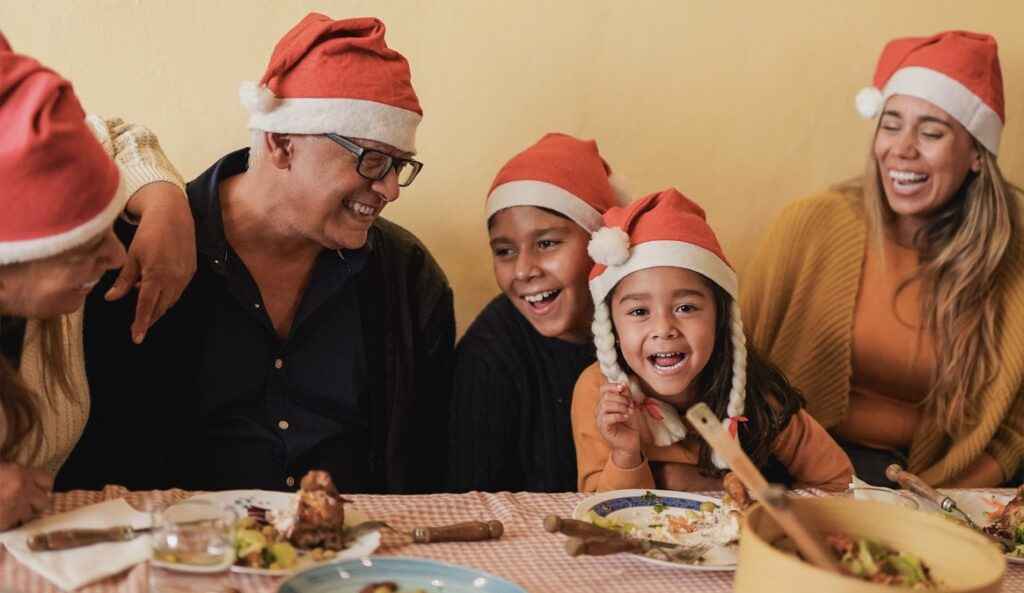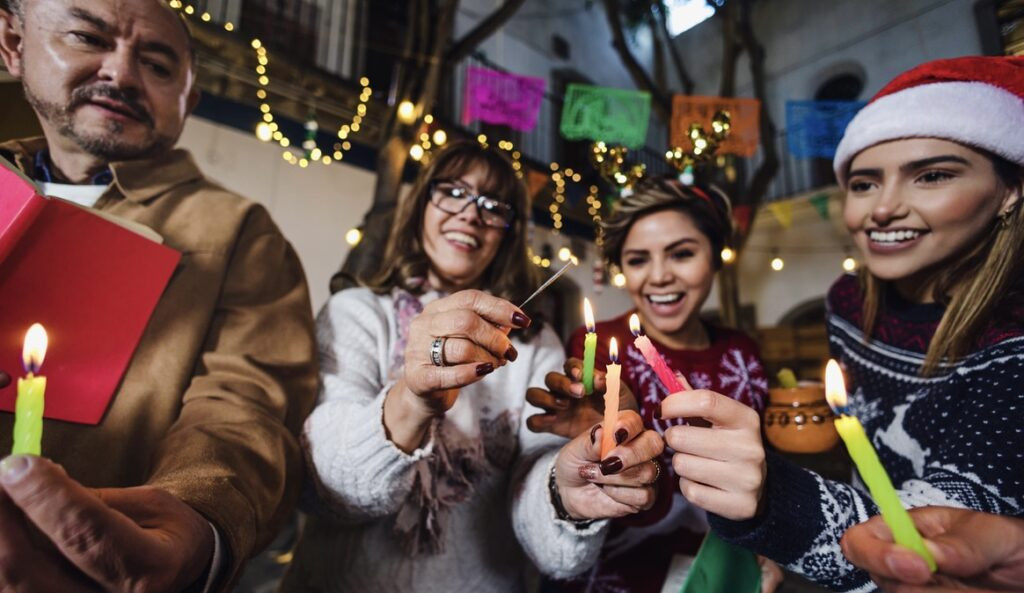Christmas in Mexico, known as la Navidad, is an enchanting time filled with vibrant traditions and heartwarming celebrations, especially for the LGBTQ+ community. Discover the magic of las Fiestas Navideñas with gaymexico.net, your go-to source for inclusive travel and cultural experiences in Mexico. Let’s explore the festive season together.
1. What is the primary name for Christmas in Mexico?
The primary name for Christmas in Mexico is la Navidad. While you might hear various terms like las Posadas, Nochebuena, and el Día de los Tres Reyes referring to specific celebrations within the Christmas season, la Navidad is the direct translation and most common term for Christmas itself. Beyond just a single day, the entire festive period is often called las Fiestas Navideñas, emphasizing the numerous celebrations that take place.
2. When does Mexico celebrate Christmas, and what is Nochebuena?
Mexico celebrates Christmas primarily on December 24th, known as Nochebuena, meaning “Good Night” or more aptly “Christmas Eve.” As a predominantly Catholic country due to Spanish colonization, with approximately 78% of the population identifying as Catholic, Mexicans traditionally attend midnight mass on Nochebuena, commemorating the birth of Jesus. However, the Christmas season in Mexico is extensive, stretching from mid-December to early February, encompassing various significant dates and festivities.
3. What are the key dates and festivities during las Fiestas Navideñas?
Las Fiestas Navideñas in Mexico encompass a series of vibrant celebrations spanning from early December to early February. Here are some of the most notable dates:
| Date | Festivity | Description |
|---|---|---|
| December 12 | Día de la Virgen de Guadalupe | Celebrates the Virgin of Guadalupe, a significant religious and cultural symbol in Mexico. |
| December 16-24 | Las Posadas | Nine-day celebration recreating Mary and Joseph’s search for lodging before Jesus’ birth, involving processions, singing, and festive gatherings. |
| December 24 | Nochebuena | Christmas Eve, celebrated with midnight mass and a traditional Christmas dinner (cena). |
| December 25 | Navidad | Christmas Day, a day of rest and family gatherings. |
| December 28 | Día de los Santos Inocentes | Holy Innocents Day, similar to April Fools’ Day, with lighthearted pranks and jokes. |
| January 6 | Día de los Tres Reyes Magos | Three Kings Day, when children traditionally receive gifts brought by the Three Wise Men. |
| February 2 | Candelaria | Candlemas, marking the end of the Christmas season, often celebrated with tamales provided by whoever found the baby Jesus figurine in the Rosca de Reyes on Three Kings Day. |
4. How does Mexico celebrate Christmas with Las Posadas?
Las Posadas are a unique and cherished Mexican Christmas tradition. These celebrations, based on the Nativity story, take place for nine consecutive nights leading up to Nochebuena. Each night, a group led by individuals dressed as Mary and Joseph, accompanied by musicians and singers, visits different houses. They enact Mary and Joseph’s search for lodging (posada) through a traditional call and response song with those inside the house. Once “lodging” is granted, everyone gathers to sing villancicos (Christmas carols), and children break a piñata filled with candy and treats. These festive gatherings foster community spirit and religious reflection during the Christmas season.
5. What are villancicos and piñatas, and how are they part of Mexican Christmas?
Villancicos are Mexican Christmas carols, often sung by children or choirs in streets and homes, adding a musical dimension to the festive atmosphere. Piñatas, while originating from Europe, have been enthusiastically embraced by Mexican culture. Typically made of paper mache or clay and filled with sweets, piñatas come in various vibrant shapes and are a source of great fun at Christmas celebrations. A blindfolded child attempts to break the piñata with a stick while others sing, creating joyous moments for everyone involved.
 traditional-piñata-hangs-between-two-buildings-during-christmas-in-mexico-city
traditional-piñata-hangs-between-two-buildings-during-christmas-in-mexico-city
6. What are some traditional Mexican Christmas foods?
Mexican Christmas cuisine is a delightful array of flavors and textures, recognized by UNESCO as a cultural treasure. Here are some of the most beloved dishes:
- Tamales: Corn dough pockets wrapped in corn or banana leaves, filled with chicken, pork, cheese, or fish, and various sauces.
- Ensalada de Nochebuena (Christmas Eve Salad): A colorful salad with lettuce, pomegranate, mandarin oranges, jicama, nuts, and dressing.
- Pavo Navideño (Christmas Turkey): Turkey prepared in various ways, often with adobo, a sauce made with chili peppers.
- Ponche Navideño (Spiced Punch): A warm drink with fruits, cinnamon, sugarcane, and piloncillo (brown sugar), sometimes spiked with rum.
- Bacalao (Salted Codfish): Salted cod soaked, sauteed with onion, tomato, olives, potatoes, and served with a bolillo (roll).
7. What are common Mexican Christmas decorations?
Mexico decorates beautifully for Christmas with vibrant colors and meaningful symbols. Common decorations include:
- Nochebuena (Poinsettias): These iconic red flowers are seen everywhere, adding a festive touch.
- Luminarias: Lit candles in paper holders, often used in Las Posadas.
- Nacimientos (Nativity Scenes): Traditional displays depicting the birth of Jesus, often the centerpiece of home decorations.
8. How does gift-giving work in Mexico during Christmas?
Gift-giving in Mexico differs from the traditional Santa Claus model. While Santa Claus has gained some popularity due to U.S. influence, children typically receive their main gifts on January 6th, Día de los Tres Reyes Magos (Three Kings Day). It’s believed that the Three Wise Men bring gifts, mirroring the gifts they presented to baby Jesus. However, families might exchange smaller gifts on Nochebuena as well.
9. What is Día de los Santos Inocentes and how is it celebrated?
Día de los Santos Inocentes (Holy Innocents Day) on December 28th is similar to April Fools’ Day. People play pranks and jokes on each other. Although its origins are religious, it is now celebrated with lighthearted fun.
10. What is celebrated on January 6th (Día de los Tres Reyes Magos) and February 2nd (Candelaria)?
On January 6th, Día de los Tres Reyes Magos (Three Kings Day), children receive gifts from the Three Wise Men. Families also share Rosca de Reyes, a sweet bread with a hidden baby Jesus figurine. The person who finds the figurine must host a tamale party on February 2nd, Candelaria (Candlemas), marking the end of the Christmas season.
11. How is New Year’s celebrated in Mexico?
Mexico celebrates New Year’s Eve (Año Nuevo) with family dinners (cenas), often featuring traditional Christmas dishes. People eat twelve grapes at midnight, making a wish with each grape for the coming months. Fireworks displays are common.
12. What is the significance of Día de la Virgen de Guadalupe on December 12th?
Día de la Virgen de Guadalupe (Virgin of Guadalupe Day) on December 12th is a national feast day celebrating the Virgin of Guadalupe, Mexico’s patron saint. Ceremonial dances (Danza de los Matachines) honor the nation’s indigenous roots, and many Mexicans visit the Basilica of Guadalupe in Mexico City to pay their respects.
13. How can I learn more about Mexican culture and Spanish?
To immerse yourself in Mexican culture and learn Spanish, consider using resources like Rosetta Stone. Their bite-sized lessons can help you learn quickly and perfect your accent in a fun, immersive environment.
14. Is Santa Claus a traditional figure in Mexican Christmas celebrations?
While Santa Claus has gained popularity in Mexico due to the influence of U.S. culture, he is not traditionally part of Mexican Christmas celebrations. Instead, the Día de los Tres Reyes Magos (Three Kings Day) on January 6th is when children typically receive gifts, brought by the Three Wise Men.
 family-with-santa-hats-celebrating-christmas-in-mexico
family-with-santa-hats-celebrating-christmas-in-mexico
15. What is the Rosca de Reyes, and what does it symbolize?
The Rosca de Reyes is a traditional sweet bread eaten on January 6th, Día de los Tres Reyes Magos (Three Kings Day). It’s a ring-shaped pastry decorated with dried and candied fruits, symbolizing the jewels in a king’s crown. Hidden inside the bread is a small plastic figurine representing baby Jesus. The person who finds the figurine is responsible for hosting a tamale party on Candelaria (Candlemas) on February 2nd.
16. What is the connection between el Día de los Tres Reyes and La Candelaria?
La Candelaria (Candlemas) on February 2nd is intimately connected with el Día de los Tres Reyes Magos (Three Kings Day) on January 6th. The person who finds the plastic baby Jesus figurine in the Rosca de Reyes on Three Kings Day is obligated to provide tamales for the same group of people on February 2nd. This tradition links the end of the Christmas season with a final celebration.
17. How can the LGBTQ+ community celebrate Christmas in Mexico?
The LGBTQ+ community can fully embrace the festive spirit of Christmas in Mexico. By participating in traditional celebrations, exploring LGBTQ+-friendly destinations, and connecting with local communities, individuals can create meaningful and inclusive experiences. Gaymexico.net offers resources and information to help LGBTQ+ travelers navigate and enjoy their time in Mexico.
18. What resources does gaymexico.net offer for LGBTQ+ travelers during the Christmas season?
Gaymexico.net provides a comprehensive guide for LGBTQ+ travelers looking to experience Christmas in Mexico. Resources include:
- Detailed travel guides for LGBTQ+-friendly cities and regions in Mexico.
- Listings of LGBTQ+ events, bars, clubs, and hotels open during the Christmas season.
- Information on local LGBTQ+ organizations and community resources.
- Tips for safe and comfortable travel as an LGBTQ+ individual in Mexico.
- Cultural insights to help understand and appreciate Mexican traditions.
19. Are there any safety tips for LGBTQ+ travelers during Christmas in Mexico?
While Mexico is generally welcoming, LGBTQ+ travelers should take certain precautions. Research local laws and customs, be aware of your surroundings, and stick to reputable establishments. Gaymexico.net offers specific safety tips and advice for LGBTQ+ travelers in Mexico.
20. How can I find LGBTQ+-friendly accommodations during Christmas in Mexico?
Gaymexico.net lists LGBTQ+-friendly hotels, guesthouses, and vacation rentals in popular destinations throughout Mexico. These establishments are known for their inclusive policies and welcoming atmosphere.
21. Are there any LGBTQ+ Christmas events or parties in Mexico?
Yes, many cities in Mexico host LGBTQ+ Christmas events and parties. Check gaymexico.net for updated listings of events, including holiday-themed gatherings, concerts, and celebrations.
22. How can I connect with the local LGBTQ+ community during my Christmas visit to Mexico?
Gaymexico.net provides information on local LGBTQ+ organizations and community centers in Mexico. These organizations often host events and gatherings during the Christmas season, offering opportunities to connect with locals and build community.
23. What are some LGBTQ+-friendly destinations in Mexico to celebrate Christmas?
Popular LGBTQ+-friendly destinations in Mexico include:
- Puerto Vallarta: Known for its vibrant LGBTQ+ scene and beautiful beaches.
- Mexico City: Offers a thriving LGBTQ+ community, cultural attractions, and festive Christmas celebrations.
- Guadalajara: Boasts a rich cultural heritage and a welcoming atmosphere for LGBTQ+ travelers.
- Cancun: Combines beautiful beaches with a growing LGBTQ+ scene.
24. How can I learn about the history and culture of the LGBTQ+ community in Mexico?
Gaymexico.net offers articles and resources on the history and culture of the LGBTQ+ community in Mexico. You can also visit local museums, attend cultural events, and engage with community organizations to learn more.
25. How can I ensure a respectful and authentic cultural experience during my Christmas visit?
To ensure a respectful and authentic cultural experience, take the time to learn about Mexican traditions, customs, and etiquette. Be mindful of local sensitivities and dress appropriately when visiting religious sites. Engaging with local communities and supporting local businesses can also enrich your experience.
26. What are some common Spanish phrases related to Christmas in Mexico?
Here are some useful Spanish phrases for celebrating Christmas in Mexico:
| Phrase | Translation |
|---|---|
| Feliz Navidad | Merry Christmas |
| Próspero Año Nuevo | Happy New Year |
| Las Posadas | The Inns |
| Nochebuena | Christmas Eve |
| Día de los Reyes Magos | Three Kings Day |
| Villancicos | Christmas Carols |
| Un abrazo | A hug |
| Muchas gracias | Thank you very much |
| ¿Cómo está? | How are you? |
27. How does Mexico’s predominantly Catholic faith influence Christmas celebrations?
Mexico’s strong Catholic tradition profoundly shapes its Christmas celebrations. Religious observances such as midnight mass on Nochebuena and the reenactment of the Nativity story in Las Posadas are central to the festivities. The Virgin of Guadalupe, a revered figure in Mexican Catholicism, is celebrated on December 12th, marking the start of the Christmas season.
28. How can I make the most of my Christmas celebration in Mexico?
To make the most of your Christmas celebration in Mexico:
- Plan ahead: Book accommodations and transportation in advance.
- Learn basic Spanish phrases: Enhance your interactions with locals.
- Embrace local traditions: Participate in Las Posadas, attend mass, and sample traditional foods.
- Connect with the LGBTQ+ community: Attend local events and gatherings.
- Stay safe: Be aware of your surroundings and take necessary precautions.
29. What is the significance of the Danza de los Matachines during the Christmas season?
The Danza de los Matachines, a ceremonial dance performed on December 12th during the celebration of the Virgin of Guadalupe, honors Mexico’s indigenous roots. The dance is a vibrant and colorful expression of faith and cultural identity.
30. What are some unique regional Christmas traditions in Mexico?
Mexico’s diverse regions offer unique Christmas traditions:
- Oaxaca: Known for its elaborate nacimientos (nativity scenes) and traditional dances.
- Yucatán: Celebrates with Las Posadas processions and traditional Mayan dishes.
- Veracruz: Features lively street parties and musical performances.
- San Miguel de Allende: Offers a charming colonial setting and festive atmosphere.
31. What are the origins of the poinsettia flower and its connection to Christmas in Mexico?
The poinsettia, known as Nochebuena in Mexico, is native to the country. According to legend, a poor child unable to afford a gift for Jesus on Christmas Eve gathered weeds and placed them at the altar. Miraculously, the weeds transformed into beautiful red flowers, now symbolizing the spirit of Christmas.
32. What is the significance of the star-shaped piñata during Las Posadas?
During Las Posadas, the traditional piñata is often star-shaped with seven points, representing the seven deadly sins. The act of breaking the piñata symbolizes overcoming temptation and receiving the rewards of faith.
33. What is the role of music in Mexican Christmas celebrations?
Music plays a central role in Mexican Christmas celebrations. Villancicos (Christmas carols) fill the air, and traditional instruments like guitars, trumpets, and drums accompany festive processions and gatherings.
34. How can I experience the religious aspects of Christmas in Mexico?
To experience the religious aspects of Christmas in Mexico, attend midnight mass on Nochebuena, participate in Las Posadas processions, and visit local churches and cathedrals.
35. What are some sustainable travel tips for celebrating Christmas in Mexico?
To travel sustainably during Christmas in Mexico:
- Support local businesses: Shop at local markets and eat at family-owned restaurants.
- Respect local customs: Be mindful of cultural traditions and sensitivities.
- Reduce your environmental impact: Use public transportation, avoid single-use plastics, and conserve water and energy.
36. What is the history of the Rosca de Reyes bread?
The Rosca de Reyes bread has its roots in medieval Europe and was brought to Mexico by the Spanish. The ring shape symbolizes the eternal love of God, and the hidden baby Jesus figurine represents the need to find Christ.
37. How can I learn to make traditional Mexican Christmas dishes?
To learn to make traditional Mexican Christmas dishes, take a cooking class, consult cookbooks, or find recipes online. Many local restaurants also offer cooking demonstrations.
38. What is the significance of the sugarcane sticks in Ponche Navideño?
The sugarcane sticks in Ponche Navideño (Christmas punch) symbolize the sweetness of life and the joy of the Christmas season. They are often used to stir the punch and add a hint of flavor.
39. What are some examples of Christmas pranks played on Día de los Santos Inocentes?
On Día de los Santos Inocentes (Holy Innocents Day), common pranks include borrowing money and not returning it, placing fake insects on people’s belongings, and spreading false rumors.
40. How can I dress appropriately for Christmas celebrations in Mexico?
Dress modestly when visiting religious sites. For festive gatherings, dress in bright colors and comfortable clothing. A traditional rebozo or sarape can add a touch of Mexican flair and keep you warm.
 villancicos-in-mexico-lighting-candles-to-celebrate-christmas
villancicos-in-mexico-lighting-candles-to-celebrate-christmas
Celebrating Christmas in Mexico offers a unique and enriching experience, especially for the LGBTQ+ community. Whether you are exploring the cultural traditions, savoring the delicious cuisine, or connecting with local communities, Mexico provides a welcoming and festive atmosphere. For more information and resources, visit gaymexico.net, your trusted guide for LGBTQ+ travel in Mexico.
Address: 3255 Wilshire Blvd, Los Angeles, CA 90010, United States
Phone: +1 (213) 380-2177
Website: gaymexico.net
Discover the magic of Christmas in Mexico with gaymexico.net. Explore our travel guides, find LGBTQ+ events, and connect with the community. Plan your unforgettable Christmas adventure today Explore Mexico safely and joyfully.